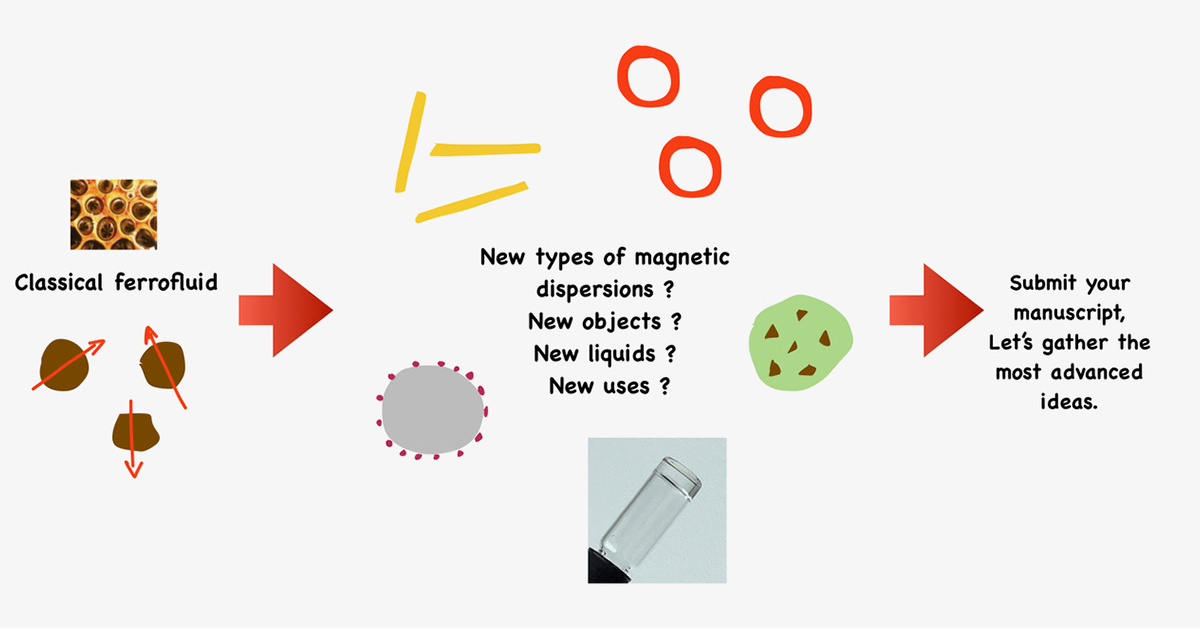Advanced Design of Ferrofluids
A special issue of Materials (ISSN 1996-1944). This special issue belongs to the section "Electronic Materials".
Deadline for manuscript submissions: closed (31 December 2021) | Viewed by 386

Special Issue Editor
Interests: structure and dynamics of complex charged systems; magnetic colloidal dispersions in ionic liquids, polar solvents, and their mixtures: dispersion and properties; relation between structure and properties, for example, thermodiffusive behaviors; interfacial properties between liquid and solid particles or porous solids; charge of colloidal objects; dynamics of species in charged porous systems
Special Issue Information
Dear Colleagues,
Ferrofluids, also known as magnetic liquids, are smart materials that have had many applications since their discovery in the 1960s. These dispersions of ferromagnetic nanoparticles in various liquids associate the properties of the nanoparticles with the liquid, conferring—to the combined system—numerous properties that can be modulated by homogeneous or nonhomogeneous and static or oscillating magnetic fields. While the first ferrofluids were obtained by grinding iron oxide in oil in the presence of surfactants, many other combinations have subsequently emerged: various magnetic materials, different sizes and shapes of nanoparticles, surface functionalizations of nanoparticles, different types of dispersing liquids, etc. The initial applications were then extended to a very wide range of fields, including biomedical, microfluidics, composite materials, sensors, patterning, and soft robots; however, this probably marks only the beginning of the even wider use and increasing richness and variety of these systems.
This Special Issue aims to review the current research on innovative ferrofluids with new properties provided by their composition, their manufacturing process, or other tools for uses that rely on their dispersed state as the source of their unique properties. The objective is thus to bring together papers ranging from synthesis to properties or new applications of new original ferrofluids.
Dr. Emmanuelle Dubois
Guest Editor
Manuscript Submission Information
Manuscripts should be submitted online at www.mdpi.com by registering and logging in to this website. Once you are registered, click here to go to the submission form. Manuscripts can be submitted until the deadline. All submissions that pass pre-check are peer-reviewed. Accepted papers will be published continuously in the journal (as soon as accepted) and will be listed together on the special issue website. Research articles, review articles as well as short communications are invited. For planned papers, a title and short abstract (about 100 words) can be sent to the Editorial Office for announcement on this website.
Submitted manuscripts should not have been published previously, nor be under consideration for publication elsewhere (except conference proceedings papers). All manuscripts are thoroughly refereed through a single-blind peer-review process. A guide for authors and other relevant information for submission of manuscripts is available on the Instructions for Authors page. Materials is an international peer-reviewed open access semimonthly journal published by MDPI.
Please visit the Instructions for Authors page before submitting a manuscript. The Article Processing Charge (APC) for publication in this open access journal is 2600 CHF (Swiss Francs). Submitted papers should be well formatted and use good English. Authors may use MDPI's English editing service prior to publication or during author revisions.
Keywords
- magnetic colloidal dispersions
- magnetic liquids
- synthesis of ferrofluids
- properties of ferrofluids
Benefits of Publishing in a Special Issue
- Ease of navigation: Grouping papers by topic helps scholars navigate broad scope journals more efficiently.
- Greater discoverability: Special Issues support the reach and impact of scientific research. Articles in Special Issues are more discoverable and cited more frequently.
- Expansion of research network: Special Issues facilitate connections among authors, fostering scientific collaborations.
- External promotion: Articles in Special Issues are often promoted through the journal's social media, increasing their visibility.
- e-Book format: Special Issues with more than 10 articles can be published as dedicated e-books, ensuring wide and rapid dissemination.
Further information on MDPI's Special Issue polices can be found here.






